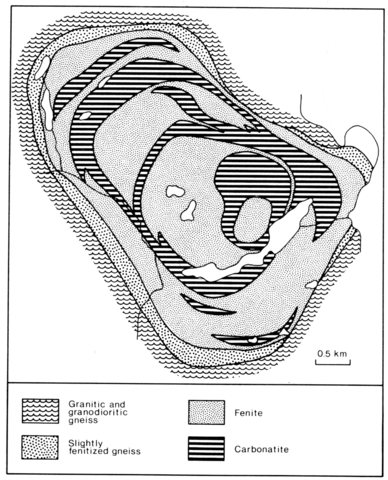stripes
This complex of carbonatites and fenites covers 15 km2, is poorly exposed, and is the only known Mesozoic carbonatite in Greenland. It comprises a number of ring dykes of carbonatite enclosing and surrounded by fenitized Precambrian granitic and granodioritic gneisses. The ring dyke carbonatites are principally sovites with locally small areas of dolomitic and rare earth carbonate rocks. They contain a little dark mica, magnetite, apatite, aegirine, alkali amphibole and pyrochlore. Silicocarbonatites and ultramafic rocks with dominant and variable phlogopite, alkali amphiboles and olivine are also present. Late carbonatite dykes are beforsites of dolomite and ankerite and these grade locally into breccias. The fenites involve the replacement of quartz, mainly by albite, aegirine and alkali amphiboles; fenite blocks in carbonatite have mica-rich rims. Late lamprophyric dykes with large phlogopites are also associated with the complex (Knudsen, in press a).
KNUDSEN, C. in press a. Investigations of the Qaqarssuk carbonatite complex, southern West Greenland. Rapport, Gronlands Geologiske Undersogelse.
KNUDSEN, C. in press b. Apatite accumulations in the Qaqarssuk carbonatite complex, southern West Greenland. In R.P. Sheldon and A.J.G. Notholt (Eds). Phosphate deposits of the World. 2. Cambridge University Press.
KUNZENDORF, H. and SECHER, K. in press. Dispersion of niobium and phosphorous in soil overlying the Qaqarssuk carbonatite complex, southern West Greenland. Journal of Chemical Exploration.
K. Secher, personal communication, 1984.
LARSEN, L.M., REX, D.C. and SECHER, K. 1983. The age of carbonatites, kimberlites and lamprophyres from southern West Greenland: recurrent alkaline magmatism during 2500 million years. Lithos, 16: 215-21.
VUOTOVESI, T. 1975. A new find of carbonatite in West Greenland, the Qaqarssuk ring-dike. Unpublished M.Sc. thesis, University of Helsinki.

